Maultasche facts for kids
 |
|
| Type | Pasta |
|---|---|
| Place of origin | Germany |
| Region or state | Swabia |
| Main ingredients | Pasta dough, minced meat, smoked meat, spinach, bread crumbs, onions |
Maultaschen are a special kind of large, tasty dumpling from Swabia, a region in Germany. Imagine a big pocket of pasta dough! These pockets are filled with yummy ingredients like minced meat, smoked meat, spinach, bread crumbs, and onions. They are also seasoned with different herbs and spices, such as pepper, parsley, and nutmeg.
Maultaschen are usually about 8 to 12 centimeters (around 3 to 5 inches) wide. They can be square or rectangular in shape.
In 2009, the European Union gave Maultaschen a special title: 'Protected Geographical Indication (PGI)'. This means that real Maultaschen (also called Schwäbische Maultaschen) can only be made in Swabia. This rule helps protect the traditional way of making them and shows how important this dish is to the culture of Baden-Württemberg, a German state.
A Bit of History
In Swabia, Maultaschen are a traditional dish often eaten during Lent. Lent is a time when some Christians choose not to eat meat. But Maultaschen are a bit funny because the meat inside is hidden by the pasta dough. People used to joke that God couldn't see the meat!
One story says that monks from Maulbronn Abbey created Maultaschen for this very reason. There's even a funny nickname for them in Swabian German: Herrgottsbescheißerle. This means "small God-cheaters"!
The name Maultaschen has a few possible meanings. One idea is that it comes from "Maul" (meaning "mouth" or "snout" of an animal) and "Tasche" (meaning "bag"). So, it could mean "mouth bag" or "feedbag," maybe because of its shape. Another idea is that it comes from an old word for a "slap in the face," comparing the dumpling's shape to a swollen cheek. A third idea is that the name just comes from Maulbronn Abbey, meaning "Maulbronn bags."
How Maultaschen Are Made
Maultaschen are usually prepared in two main ways:
- In broth: They can be simmered in a tasty broth and served like a soup. This is called in der Brühe.
- With butter and onions: They can also be dressed with melted butter and onions. This is known as geschmälzt.
Some recipes for Maultaschen use bacon in the meat filling.
Did you know? Some German families in Southwest Wisconsin make a dessert with the same name! It looks similar to sliced Maultaschen, but it's sweet. It's made with flour, eggs, apples, and cinnamon.
See also
 In Spanish: Maultasche para niños
In Spanish: Maultasche para niños

